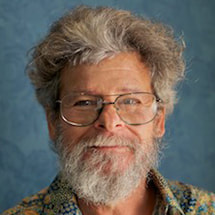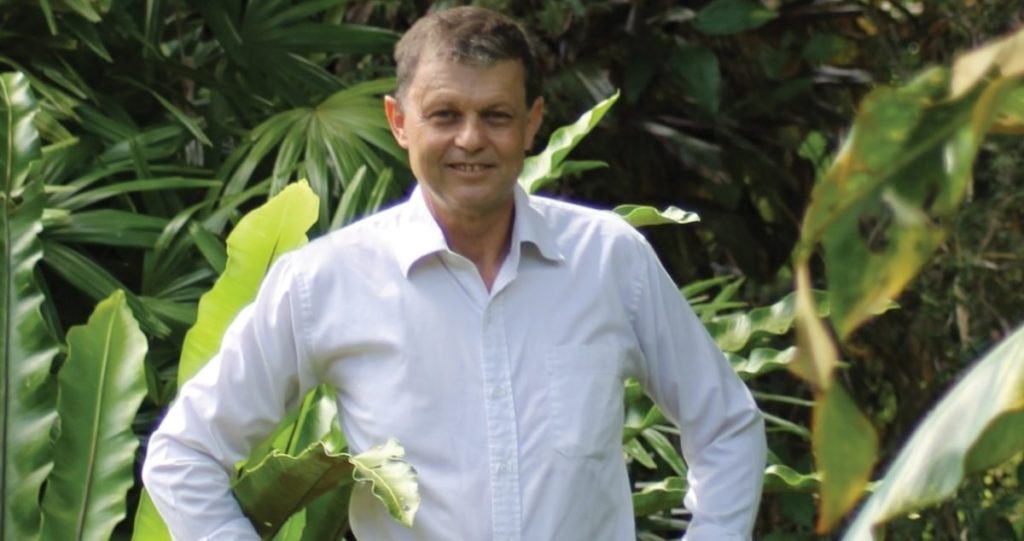A Visit to André Leu’s Regenerative Organic Fruit Farm in Queensland
“When Leu bought his 150-acre farm 20 years ago in the Daintree region of northern Australia, the land had been degraded, the native tropical rainforest destroyed. He knew most of the property would be worth far more by returning it back to the natural primary forest, so that’s just what he did. Today, 100 acres have been returned to rainforest and he grows more than 100 different species of tropical fruit on the other 50 acres.”
–Anna Lappé, writing for Civil Eats
 Methods for regenerating soil carbon and fertility have been developed for every soil and climate. I recently visited André Leu’s organic fruit farm in Queensland, Australia. I was accompanied by a Toronto documentary film crew funded by the Canadian government.
Methods for regenerating soil carbon and fertility have been developed for every soil and climate. I recently visited André Leu’s organic fruit farm in Queensland, Australia. I was accompanied by a Toronto documentary film crew funded by the Canadian government.
André Leu’s fruit farm is surrounded by conventional sugar cane farms. The soil in the sugar cane farms has around 1% organic matter. It bakes to a hard impermeable crust the plant roots can’t penetrate, especially during the latest record heat waves and droughts, so when it rains the water runs off the surface into the rivers without percolating into the soil and crops. When water forms a top soil slurry, the soil crumbs disintegrate and wash away into rivers, killing the seagrass and coral reefs in the sea.
In contrast, the fruit farm soil has about 6% organic matter (derived from compost), has much higher water holding capacity, and the soil is structurally organized into small crumbs with root passages between them. When it rains the water drains straight down into the soil, so the growing season is much longer, and the little crumbs of soil are held together by organic matter, so they don’t disintegrate and wash away.
André is a rock powder user, too. He has found that the cheapest source of finely ground basalt is the conveyor dust from gravel quarries. They usually give it away. He adds truck loads of it to his compost to make its many minerals bio-available to plants and soil microbes.
While visiting his farm, André and I took soil from his farm and from his neighbor’s farm, put each in a glass of water, gave a swirl, and let it settle. Long after André’s soil water had cleared with the intact crumbs visible at the bottom, his neighbor’s glass was opaque with mud. One farm exports mud and fertilizers into the rivers, the other retains soil, carbon, and nutrients and delivers clear runoff. If the other farmers in this area did what André Leu did, their farms would be much more productive and we could regenerate coral reefs, sea grasses, fisheries, turtles, dugongs, etc. that have been lost.
Many estimates that say that the planet is now too small to grow our way out of excess CO2, and conclude that that only industrial solutions are feasible to remove CO2, simply ignore the soil carbon building potential of regenerative land management, and assume that we will continue to destroy the biota’s capacity to regulate climate, water, and food supplies instead of strengthening it. Geoengineering proponents propose enormous changes to the entire energy structure, but seem to ignore that changes in land management could achieve the same results more cheaply.
The claim that land is insufficient to absorb CO2 effectively is based on the assumption that farmers will always continue to use the backward degenerative methods that are constantly running down their soil quality, so crops feed off chemicals instead of naturally recycled nutrients. In contrast regenerative soil management builds soil carbon, fertility, and water holding capacity. If we spend so much money and ingenuity trying to suck CO2 out of air with chemicals and pumps, we can have much more effective results at lower cost by managing the soil and biota regeneratively instead of degrading it, using methods that are already available.
The long term gains in soil carbon that can be achieved with simple methods is shown in soil organic carbon data from the classic experiment on composting, run continuously at Rothamsted Agriculture Experiment Station, England for more than 150 years. In this particular case they have tripled the carbon content of the soil, and the gains are still continuing without showing saturation. Modern carbon farming methods are more efficient, and result in much faster and longer lasting soil carbon increases, especially if biochar is part of the compost mix along with rock powders.
The major long term (geological) natural sink of atmospheric CO2 is weathering of rocks, but fossil fuel CO2 addition now is hundreds to thousands of times faster than natural CO2 sinks currently can absorb. A mixture of basalt rock powder with nitrogen-rich biological compost and biochar can provide a near perfect elemental balance of natural materials that is slow-release and extremely long lasting, decades to centuries.
In contrast, most chemical fertilizer (NPK) can’t even be used by plants because it lacks the other elements essential for their utilization, and winds up killing river, lake, and ocean ecosystems instead.
When biology increases through the right balance of biogeochemical soil materials–both mineral and organic–the rates of carbon dioxide removal and storage as biomass and soil are vastly increased. Healthy plants release organic acids, chelating agents, and mycorrhizae, as well as CO2, on rocks in order to extract the essential elements they need from ground mineral powder. Root respiration boosts soil CO2 to hundreds of times higher than the atmosphere, so rich growth of vegetation on rock powders increases CO2 weathering sinks many times faster than chemistry alone can.
Regenerative development to reverse climate change, or Bio-Geotherapy, regenerates the natural mechanisms that regulate our climate, water, and CO2 cycles. Investing CO2 in healthy strong ecosystems, with irreplaceable climate regulatory capacity, is the most sustainable and cost-effective way to grow our way out of climate change.
That’s what good farmers or gardeners do compared to bad ones: compare a fruit tree forest absorbing CO2 from the air versus barren fallow fields between crops rotting soil and plant CO2 into the air! Bad land management has been a significant part of the carbon problem, but it can easily become a major part of the solution (along with all the other partial solutions).
“We must tend our gardens.” – Voltaire’s Candide
Thomas J. F. Goreau, PhD is a board director of Remineralize the Earth, President of the Global Coral Reef Alliance, Coordinator of the Soil Carbon Alliance, non-profit organization for coral reef protection and sustainable management, and Coordinator of the United Nations Commission on Sustainable Development Partnership in New Technologies for Small Island Developing States. He works with tropical fishing communities and organizations around the world to restore their coral reefs and fisheries. He is the main editor and co-author of Geotherapy: Innovative Methods of Soil Fertility Restoration, Carbon Sequestration, and Reversing CO2 Increase, a technical book on remineralization and biochar, published by CRC Press.
André Leu is the International Director of Regeneration International, an organization that promotes food, farming and land use systems that regenerate and stabilise climate systems, the health of the planet and people, communities, culture and local economies, democracy and peace. He was the President of IFOAM, the world change agent and umbrella body for the organic sector from 2011 -2017. He lectures and teaches at universities, institutions and workshops around the world. He meets with governments, industry, farmers, consumers and NGOs on the multi-functional benefits of regenerative organic agriculture. He is the Author of Poisoning our Children and The Myths of Safe Pesticides. André and his wife, Julia, have an organic tropical fruit farm in Daintree, Australia.
For more information
Video: “André Leu – Scaling up Regenerative Organic Agriculture can Reverse Climate Change – LSSM” https://www.youtube.com/watch?v=3uLTf37LPD0
Support us on Patreon
Thank you for joining us today! Please become a member of RTE and support us on Patreon. Unlike many larger organizations, we work with a team of determined and passionate volunteers to get our message out. We aim to continue to increase the awareness of remineralization to initiate projects across the globe that remineralize soils, grow nutrient dense food, regenerate our forests’ and stabilize the climate – with your help! If you can, please support us on a monthly basis from just $2, rest assured that you are making a big impact every single month in support of our mission. Thank you!








Greg O'Neill
March 14, 2019 (3:24 pm)
Hi Tom, would love to dialog with you and Andre about White Tiger Farm update for Ashland, OR, and Hilo, HI, as well as elsewhere, such as USVI, and Costa Rica. Ashland has plenty of basalt under the surface, and at the surface of properties I will buy for farm sites to process into rock dust powder as a soil amendment, and to go with food forestry / edible landscaping.